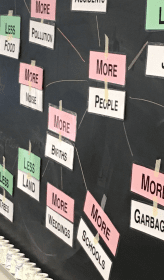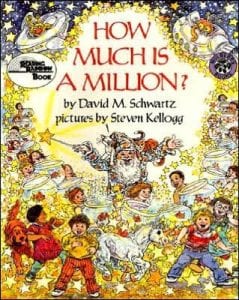A few weeks ago I traveled to beautiful, windy Indiana to present PopEd workshops to pre-service teachers. The classes I visited focused primarily on teaching science and developing science curricula for elementary school classrooms. But thanks to a special request by one of the professors hosting us, we also incorporated differentiation and discussed how it can be applied within Population Education lessons.
Many PopEd lessons already use a variety of ways to present information and incorporate a range of questioning techniques and levels. There are also plenty of opportunities to differentiate more pointedly within the lessons as I’ll point out with the elementary-level activities below.
Population Education activities – differentiated!
More or Less

In the lesson More or Less, students construct a word web, pairing the words “more” or “less” with nouns to create phrases that show the causes and effects of a growing population. A great way to differentiate is to add blank cards for students to:
- Draw a picture instead of write a word to represent their ideas (good for pre-literacy students and English Language Learners).
- Break students into small groups and assign different sets of words based on academic level.
- Have students write the words themselves, challenging them to create new ideas and then integrate them into the word web.
You can also make “More or Less” into an art project where students create their own word webs with words, drawings, photos, magazine cut-outs, stickers, etc. either in or out of class.
Millions and Billions
This activity has some differentiation already built in, as students learn about large numbers and the difference between a million and a billion through riddles, an art project, and small group problem solving. To add even more to this lesson:
 The problems in Part 3 vary in difficulty (#1 and #5 are easier for most students than #2, #3, and #4), so you can assign them to different groups based on ability.
The problems in Part 3 vary in difficulty (#1 and #5 are easier for most students than #2, #3, and #4), so you can assign them to different groups based on ability.- You can also remove the scaffolding of the problems in Part 3, challenging students to reach the ultimate solution without step-by-step guidance.
- You can also pair “Millions and Billions” with the children’s book How Much is a Million? that uses colorful, imaginative illustrations to help students grasp what a million and a billion of something might look like (see more complementary children’s book suggestions).
Water, Water Everywhere
In the first part of the lesson, students observe a demonstration of how much water is available for human use. In Part 2, students represent the proportions of Earth’s water linearly by dividing up one meter of adding machine paper into four appropriate lengths. After this you can challenge students to come up with their own ways, individually or in groups, of representing the availability of water. With the future teachers in Indiana, we discussed the following examples of what students might come up with:
- Constructing other types of graphs (bar graphs, pie chart).
- Drawing pictures with labels.
- Writing the information as a paragraph of text.
- Giving a verbal report to the teacher or class.
- Representing with a physical manipulative or counters (like beans, base-ten blocks, coins).
These are just a few ways to use differentiation with Population Education’s elementary-level lessons. Differentiation is an important concept to keep in mind both when creating lesson plans and using them in class, for all grade levels. I hope this blog will help you integrate differentiated instruction into your teaching, with PopEd activities as well as your own!


